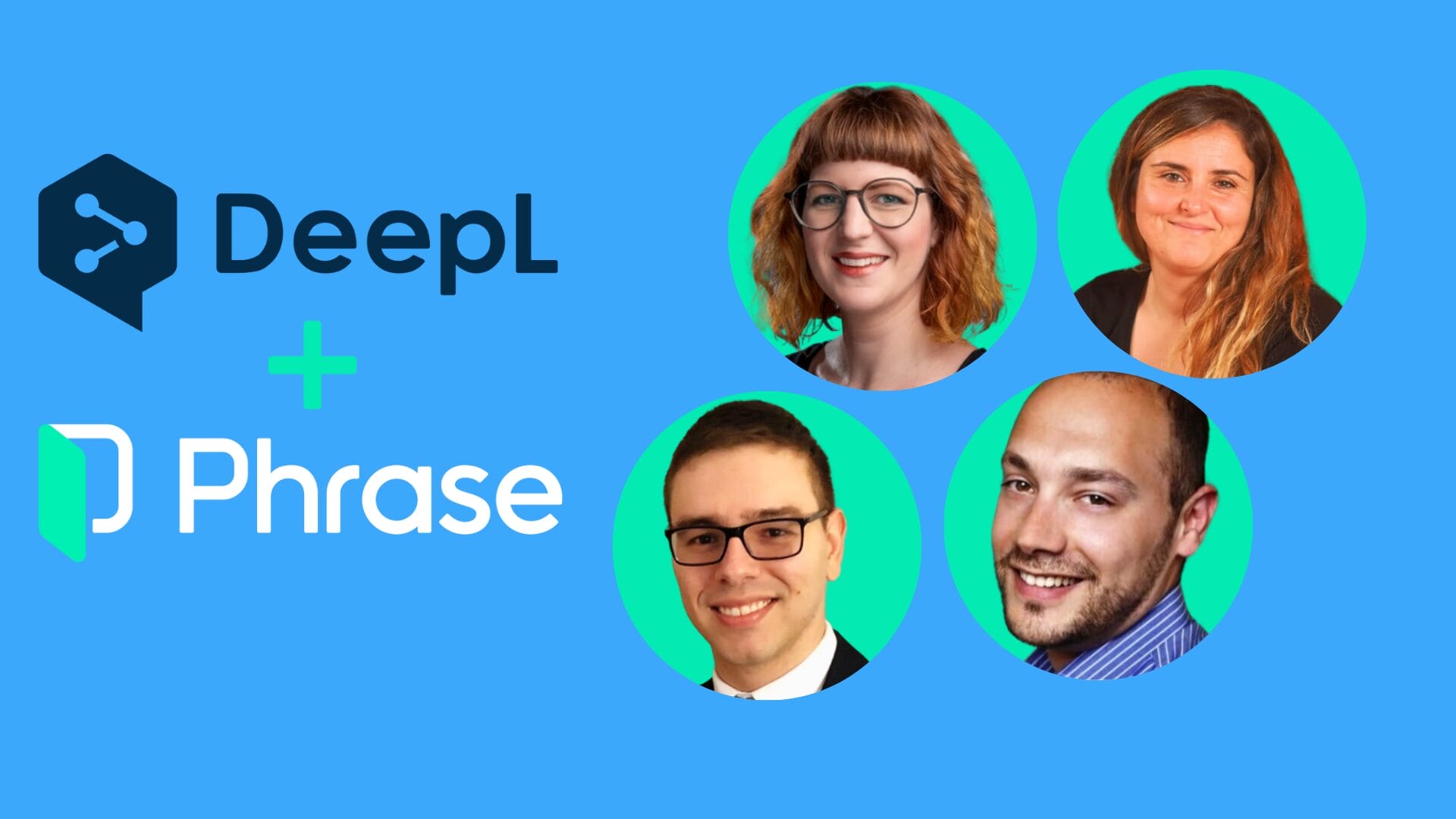Machine translation
Machine Translation Software: The Best Tools to Try (and Use) in 2025

How machine translation software has evolved over the years
Machine translation development has come a long way, evolving through different phases, each with its own ups and downs. Let’s explore the various types of MT technology—including rule-based, statistical, and neural machine translation—in this overview.
Rule-based machine translation tools
The earliest form of machine translation developed in the 1960s, rule-based MT (RBMT), relied on a large, predefined set of linguistic rules that helped the software transfer the meaning of a text between languages. It had overall low quality, and it required adding language rules manually, requiring a significant amount of machine translation post-editing.
Statistical machine translation engines
Statistical MT (SMT), pioneered in the 1990s, builds a statistical model of the relationships between words, phrases, and sentences in a given text. It applies the model to a second language to convert those elements to the new language. Thereby, it improves on rule-based MT but shares many of the same issues.
Neural machine translation systems
Ever since Google brought about the “MT neural revolution” in 2016, machine translation output has significantly improved in quality, consistency, and productivity gains. Thanks to neural machine translation (NMT), algorithms are now able to generate such accurate translations that they are beyond just “good enough,” in many cases reaching human parity in translation.
Neural machine translation software employs artificial neural networks to process and translate text by learning from extensive multilingual datasets. Most of today’s MT software providers rely on neural MT since it offers more nuanced translations and the flexibility to add new language pairs, enabling them to learn and improve with increased usage.
Large language models
Large language models (LLMs) can be seen as the next evolutionary step beyond neural machine translation. Where earlier MT approaches struggled to capture context or required extensive post-editing, LLMs excel at understanding nuance, cultural references, and domain-specific terminology.
By training on massive multilingual datasets—including non-parallel text—LLMs produce more accurate, context-sensitive translations that fit smoothly into diverse localization workflows, from global marketing copy to technical documentation. They also enable on-the-fly content adaptation and multimodal integration, translating not just text but also accompanying imagery or voice content.
As these models become more advanced, ethical considerations—like bias mitigation, transparency, and intellectual property rights—remain critical, but LLMs represent a powerful new phase in machine translation, expanding what automated language processing can achieve.
Unlock the power of machine translation
Discover advanced machine translation management features within our enterprise-ready TMS and create new business opportunities worldwide more quickly and efficiently.
Why use machine translation software?
The introduction of modern machine translation software based on neural learning has elevated MT to an essential asset in business translation.
Let’s take a closer look at the 3 core benefits of machine translation software:
- Greater speed and volume
- Enhanced accessibility
- Reduced costs
Greater speed and volume
With ongoing improvements in machine learning algorithms and hardware, machine translation software is becoming even faster and more efficient. Not only is it capable of translating millions of words almost instantaneously, but it’s also continually improving as more content is translated.
For high-volume projects, MT software not only handles volume at speed, but it can also integrate with other software platforms such as content or translation management systems to organize that content. This helps maintain the structure and meaning of content when translating it into multiple languages.
Enhanced accessibility
Most machine translation applications offer support for up to 100 languages—and some of them even more. This means that translations can be simultaneously delivered to multiple target markets, creating a win-win situation for both businesses and customers.
By breaking down language barriers and enhancing the customer experience, MT has made content, products, and services more accessible to potential buyers around the world. This expanded reach also allows businesses to grow their market share and boost their profits.
Lower costs
The combination of high-speed throughput and the ability to select from existing language pairs covering dozens of combinations means that machine translation software can reduce translation costs, even when human translators may still be post-editing.
Put simply, MT software starts the translation process by providing the initial output—human translators then come in to refine the translations, ensuring they capture the original content’s meaning and adapt it for the target audience in a specific region.
To further streamline this, automated quality scoring systems – such as Phrase QPS – can be valuable. These systems evaluate translation quality on a standardized scale, providing actionable insights into content performance. This allows linguists to efficiently identify issues and focus their efforts where they’re needed most, improving overall productivity.
Automated quality scoring also enables smarter workflows. Content can be automatically categorized by its quality level, ensuring only high-quality translations move forward, while segments requiring further refinement are directed to post-editing. This approach not only enhances efficiency but also ensures consistency and alignment with brand standards, helping businesses maintain their global reputation while optimizing costs.
What is the best machine translation software?
Given the innovation potential in neural machine translation, global tech giants have been increasingly disrupting the language industry over the years, prompting an important question: What is the best machine translation software on the market, and what sets it apart from the rest?
As much as the MT software landscape evolves rapidly, there’s no one-size-fits-all answer: The best MT software varies based on your specific translation requirements. Even the widely held belief that NMT systems deliver high-quality translations has its own intricacies and limitations.
Key factors to consider when evaluating machine translation software:
| Capabilities | Different tools may excel in specific domains, so choose one that aligns with your translation needs (e.g., medical instructions vs. marketing collateral). |
| Ease of use | Ensure the MT software has a user-friendly interface and is easy to integrate into your existing translation workflow. |
| Customization | Assess the tool’s ability to integrate language assets such as glossaries, style guides, or custom terminology. This ensures superior accuracy and brand consistency. |
| Cost | Consider the pricing model, whether it’s free, subscription-based, or per-word. |
| Support | Evaluate the level of customer support offered, which can be crucial when issues arise while integrating or using the software. |
| Privacy and security | Examine the provider’s privacy & security policy and check its implications for your business with your legal department—to safeguard against potential data loss or privacy issues. |
Google Translate
There’s hardly anyone who hasn’t heard of Google Translate. Integrated into nearly every Google Product, it can achieve high-quality results—not only for the most common language pairs but also for less widely spoken ones.
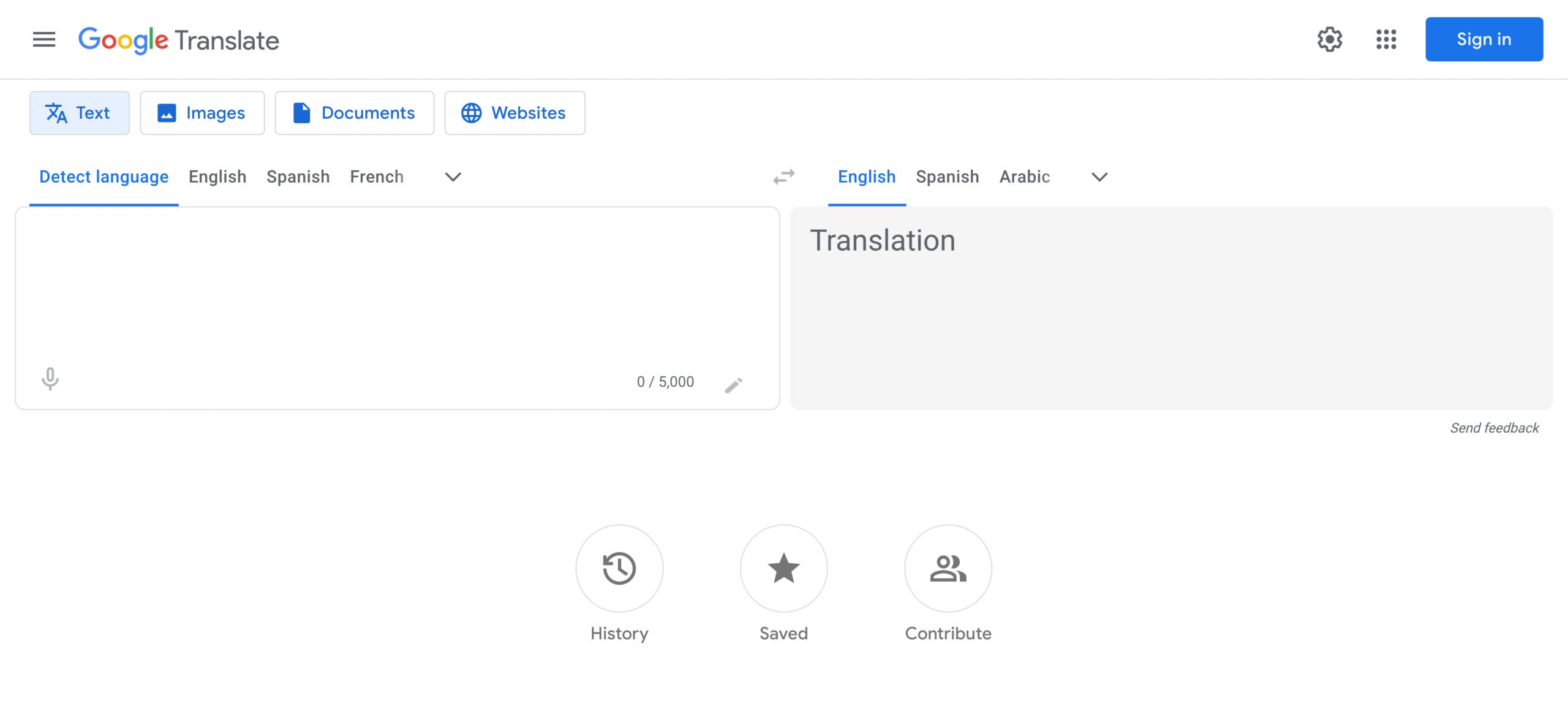
Google Translate provides a simple user interface (UI) for real-time online translation © Google Translate
Google Translate was launched in 2006, but really gained prominence in 2016, when Google made a significant leap by transitioning from a statistical, phrase-based system to a neural machine translation system. This marked the birth of Google Neural Machine Translation (GNMT), significantly improving translation quality
In fact, it was a double leap. The first part involved abandoning the statistical paradigm, which was still tied to word-for-word translation and lacked context. Recurrent neural networks or RNNs (a specific form of neural networks used to encode and decode sentences) significantly improved their ability to understand context, resulting in much more fluent translations.
While other machine translation processes were already utilizing artificial neural networks, the real innovation lay in the introduction of the so-called “attention mechanism” or Transformer.
This approach enables the system to translate lengthy sentences without sacrificing context and quality. Unlike RNNs, which gather information from each part of a sentence and can be computationally expensive, an attention layer can focus on the most critical aspects of the source text, regardless of sentence length.
With support for over 100 languages and a straightforward interface, it’s a versatile tool for basic translation needs. However, it may struggle with maintaining contextual accuracy in long or complex content and lacks advanced customization options for specific domains.
Google’s powerful Cloud API offers additional functionality, such as, importing and exporting translations into computer-assisted translation tools. More characters and features are available in the paid versions, which offer functions like creating user-defined translation models using Google AutoML, allowing users to train Google’s engine with their own bilingual data.
However, the free version is limited to basic functionality, making it less suitable for high-stakes or nuanced business use cases, and with an open system like this, it’s always worth considering the overall security, especially if you have a need to translate sensitive or confidential company information.
Dive deeper
Master the TMS RFP Process

Discover the essential steps to choosing a Translation Management System (TMS) that aligns with your organization’s unique needs. This comprehensive guide will help you create a robust Request for Proposal (RFP), offering you the tools and knowledge to make an informed and strategic decision.
DeepL
DeepL, launched in 2017, originally as a way to further develop Linguee, a database of human translations. The engineers at the German-based company applied the latest deep-learning technique (hence the company’s name) to get then-state-of-the-art machine translation software by training the models on Linguee’s data.
Deepl has a reputation for producing high-quality translations, particularly in certain language pairs. It offers customization options like terminology preferences and tone adjustments, which enhance usability. The results are very similar to the ones from Google Translate
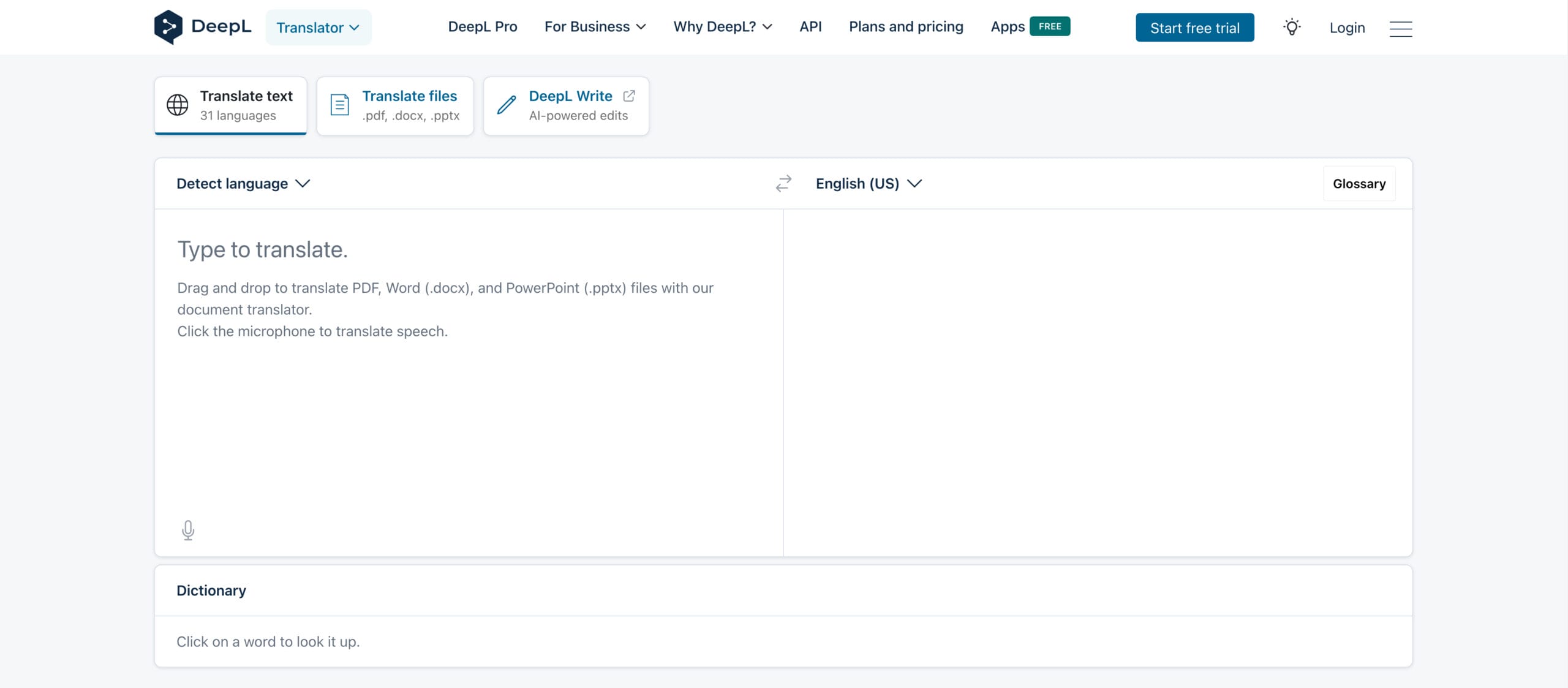
DeepL Translator offers a free machine translation software tool for integration into the Windows/iOS ecosystem. Language support is narrower than some competitors, with a total of 33 languages (as of 2024), by clicking CTRL+C twice—or translating entire Word and PowerPoint documents using drag-and-drop.
Also, both in the web interface and the standalone app, you can customize translations by “forcing” terminology for selected language pairs. Already in the free version, users can decide to use specific (corporate) terminology in their translation for certain language pairs by just switching a toggle. This way, DeepL tackles one of the weaknesses of machine translation we mentioned before—accuracy.
A wider, unlimited terminology function is available in the DeepL Pro (paid) version, along with other settings, such as the option to make the target text more formal or informal—something that can have a massive impact on the tone of voice in languages like German or Italian. While its Pro version also offers valuable features such as data encryption, a CAT tool integration, and more extensive terminology options, it lacks the ability to train custom models with proprietary data—a limitation for organizations with specific domain needs.
Despite its strengths, DeepL lacks a Translation Memory, so each piece of additional content is treated as a new file, which can lead to issues if you need to translate large volumes of content. DeepL also relies on a single machine translation engine, so its responses may be limited and it may struggle to match the quality of other tools, especially in less commonly used languages.
Dive deeper
The pros and cons of using DeepL
German-based DeepL is looking to disrupt the machine translation field. Learn more about how it works and how to use it for maximum performance and efficiency.
SYSTRAN Translate
SYSTRAN, a pioneer in machine translation since 1968, offers robust solutions powered by pure neural machine translation (PNMT).
Its free machine translation tool, SYSTRAN translate, allows users to translate text “on the go” into 140+ language combinations while trusting the power of the open-source community. “Open source” means freedom with the source code, allowing for more creative freedom and enabling technology agility. It provides a flexible and innovative platform. However, its interface and customization options can feel dated compared to newer tools.

Among the big players in the MT field, SYSTRAN is the only one sharing its knowledge—and profiting from cooperating—with OpenNMT, an open-source ecosystem for neural machine translation and neural sequence learning. This same engine, founded by SYSTRAN in December 2016, together with Harvard NLP, has already been successfully used in many research and corporate applications.
While paid subscribers can benefit from advanced features like custom model training, SYSTRAN may require more setup and expertise to achieve optimal results. It excels in technical or structured content but can be less effective for creative or contextually nuanced translations.
SYSTRAN is also one of the few companies that don’t just speak about NMT for each aspect of the translation cycle. It defines its own model as hybrid translation, combining rule-based and statistical machine translation to guarantee:
- Predictable and consistent translations
- Compliance with corporate terminology
- Out-of-domain usability
- High performance
- Learning from existing mono and multilingual corpora with minimal customization costs, etc.
Microsoft Translator
Microsoft Translator supports 90 languages and integrates seamlessly into Microsoft’s ecosystem, making it convenient for organizations already using Office, Teams, or LinkedIn. It’s based on the newest neural network technology with an attention-based model.
Microsoft officially launched Translator in 2009, but the product gained more relevance and has been updated in the last few years. Today, it’s also available as a standalone mobile app for both iPhones and Android devices.
An interesting feature in Microsoft Translator’s free version is the translation of frequently used expressions relevant to daily life. Users can quickly translate commonplace questions and statements for conversations with a single click. The app also supports the translation of street signs through image recognition.
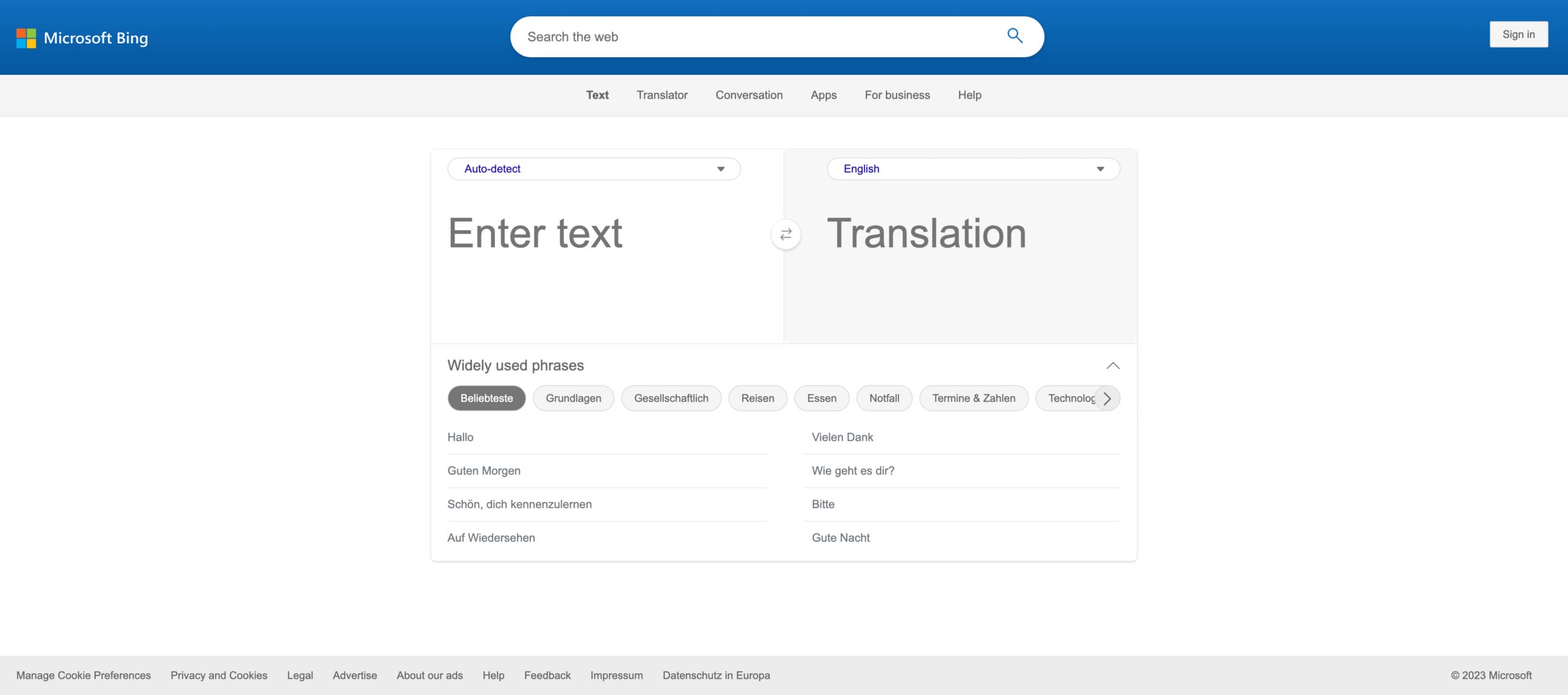
For those seeking to integrate Microsoft’s translation technology into their translation workflows through a paid subscription, the offerings are extensive. Besides the “standard” text translation, with Azure Cognitive Services Translator, it’s possible to translate entire documents, utilize a REST API, and leverage AI Containers. Most importantly, it allows for the machine translation customization.
According to Microsoft itself, with about 10K bilingual translated sentences (input and output), it’s possible to improve the translation models to fit the customer’s needs better.
While its integration capabilities and customization options are strong, its translation quality may not always match specialized tools like DeepL or Phrase Portal for certain language pairs. Additionally, its reliance on the Microsoft ecosystem may limit its appeal for businesses using non-Microsoft workflows. It is best suited for general-use cases but less ideal for niche or highly technical content.
Amazon Translate
Amazon Translate, another online machine translation system from a Big Tech company—relatively young, having been launched in 2017, delivers robust translation capabilities through AWS. Given the backing of its parent company, it’s not surprising that Amazon Translate has achieved remarkable results in the short time since its release. Users looking for a free solution might be disappointed, though: To use Amazon’s machine translation engine, you need an AWS account.
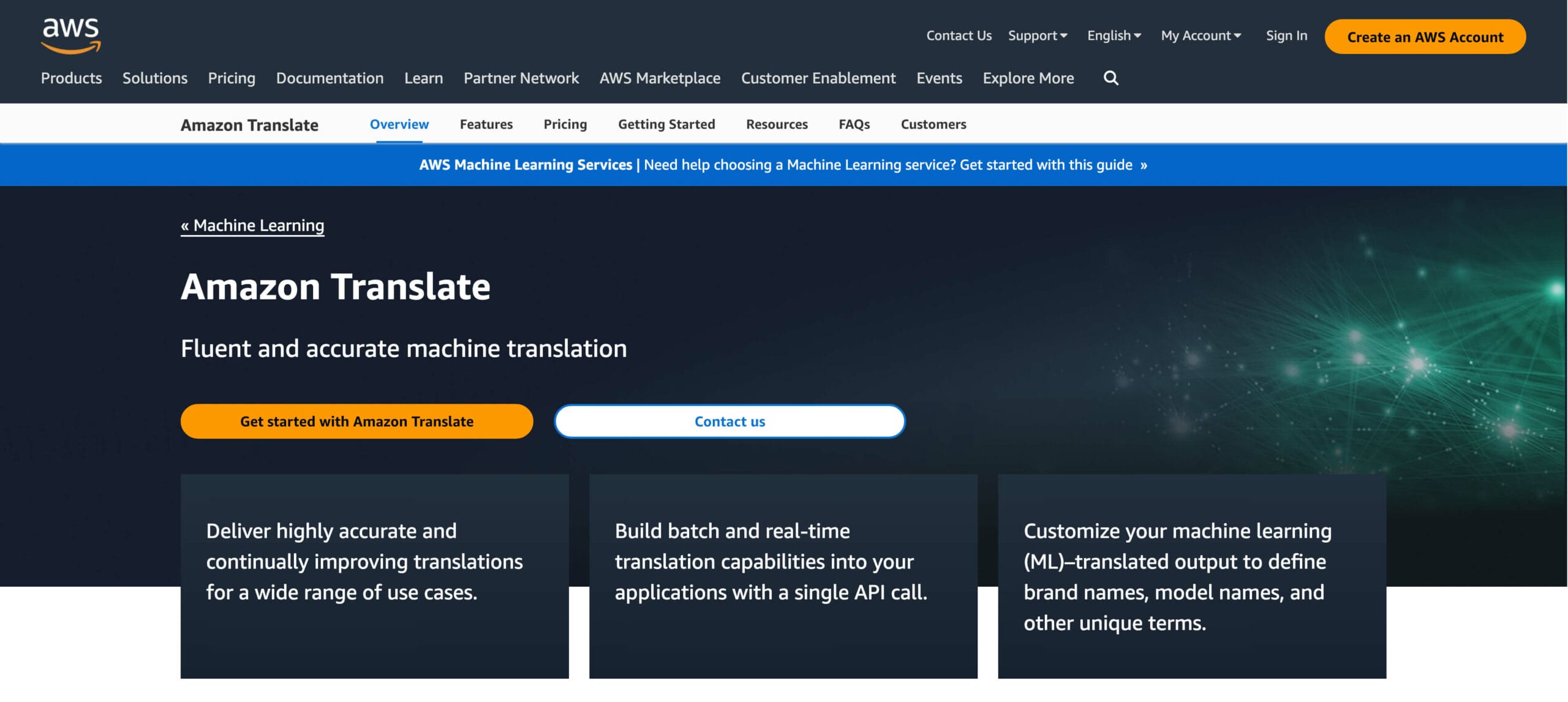
With an AWS account, you get two million free characters per month—and the range of functionalities offered by this NMT system is huge:
- Customization (terminology and parallel data)
- Encoding terminology
- Batch translation (Amazon S3), etc.
While its support for customization and parallel data is valuable, its dependency on an AWS account and pricing structure can be a barrier for smaller organizations.
The tool is best suited for high-volume enterprise projects but may require additional investment in expertise to fully leverage its potential. Its quality in less common language pairs and domain-specific translations may vary compared to other leading MT solutions.
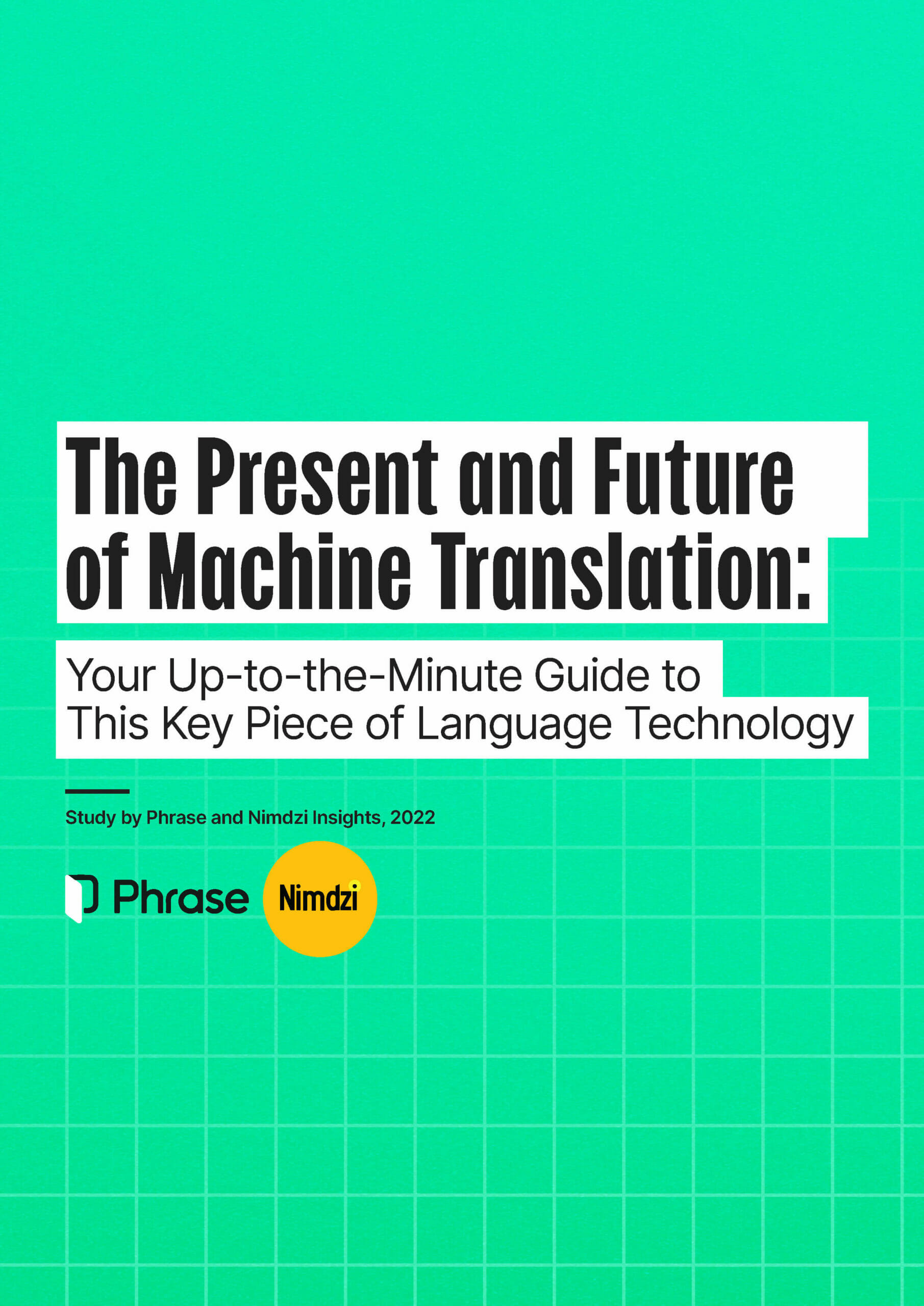
Download for free
Your up-to-the-minute guide to machine translation
Learn about new technologies to improve machine translation output quality, the latest on MT post-editing pricing models, and how to best shop for machine translation.
Phrase Portal

Of course, we’d be remiss if we didn’t highlight one of our own solutions here.
Phrase Portal is designed as a self-service translation solution that aims to bring secure, on-demand translation capabilities to teams throughout an organization.
Built to integrate with various machine translation engines—including DeepL, Google, and LLM-based models—it automatically selects the most suitable engine based on language pair and domain, making it a flexible option for a wide range of translation needs.
Phrase Portal’s interface is user-friendly and accessible to non-specialists, allowing employees in – for example – marketing, HR, or legal departments to translate content without relying on localization teams.
Thanks to its integration with translation memories, glossaries, and custom MT profiles, it can tailor each department’s needs with customized translations, or even personalized portals, maintain brand consistency and preferred terminology for each department across multiple languages.
On the security front, Phrase Portal focuses on enterprise-grade measures, including data protection and controlled user access, which can be crucial for organizations dealing with sensitive information and looking to avoid the risks associated with open, public MT tools. The platform can handle a variety of file types, allowing users to translate everyday documents quickly and securely.
Phrase Portal’s emphasis on security, integration, and consistent terminology makes it a strong contender—particularly for organizations handling sensitive information—smaller teams or those with minimal translation requirements might find its feature set more than they need.
Phrase Portal offers a richer ecosystem and more advanced controls that can streamline multilingual workflows at scale, especially compared to simpler, more budget-friendly tools. Ultimately, its suitability depends on the complexity of your organization’s needs and the value placed on enterprise-level security and customization.
What about ChatGPT?
We also need to mention OpenAI’s ChatGPT in the conversation about the best solutions for automated translation, especially given how much attention generative AI has been attracting recently.
While not necessarily built with translation in mind, GPT-like applications can easily perform language-related tasks and are a viable and attractive alternative to the more established MT solutions mentioned above.
In fact, GPT-4o (and other large language model-based solutions such as Claude 3 Opus, PaLM2 Text Unicorn, or Google’s own Gemini Pro 1.5, among others) perform as well as MT solutions. In some combinations of domain and language pairs, they can possibly even outperform MT. Today, LLM-enabled translation is quickly becoming a part of the language services landscape.
As in the previously mentioned cases, GPT-like applications come with their pros and cons, which businesses need to carefully weigh-up when considering automated translation solutions:
- LLM-based automated translation is cheaper than traditional MT,
- Yet it is also significantly slower than traditional MT, making it less suitable for scenarios where real-time translation capabilities are needed
- Same as MT, LLMs offer potential for customization through the use of techniques such as retrieval-augmented generation (RAG) or prompt engineering
Choosing the right machine translation tool for your needs
This overview shows that even though almost all machine translation developers have moved towards NMT, each provider has gone in its own way.
On one hand, there’s the strategy of reaching a broader audience with a completely free, user-friendly tool. On the other hand, some providers offer more customization options geared towards tailoring the tool to your specific needs.
Recognizing that each provider has its strengths and weaknesses, it’s clear that there’s no single best machine translation software—nor a one-size-fits-all solution.
The best approach to selecting machine translation tools is to thoroughly evaluate all providers, ideally utilizing each one’s strengths in terms of language pairs, domain, and infrastructure.
This will help you find the right combination of MT engines to meet your specific translation needs. However, you can unlock the full potential of machine translation only when you’re able to access and use all tools in one place. Thanks to a cloud-based translation management system, this is now well within your grasp.
Make the most of MT software with The Phrase Localization Platform
When businesses need to utilize machine translation at scale, they need technology that can provide them with the best of both worlds: efficiency and quality.
While the Phrase TMS was already a powerful solution, utilizing additional platform capabilities like Phrase Portal allows organizations to broaden the scope of their multilingual initiatives while maintaining central oversight and enterprise-level security.
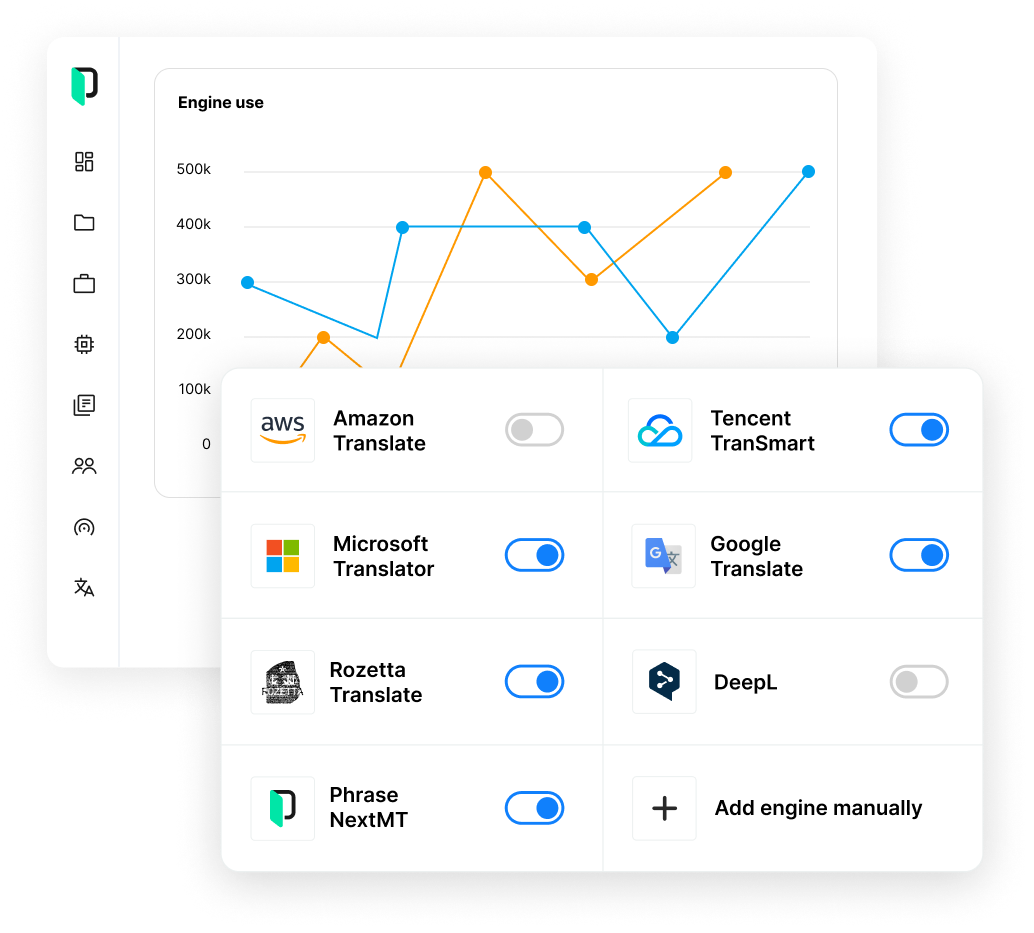
Fully embedded into Phrase TMS, the advanced MT management capabilities that come with Phrase Language AI let you:
- Start translating immediately with no developer time or effort using fully managed MT engines from leading providers like Google, Amazon, DeepL, or Microsoft.
- Add any of the 30+ supported generic and custom engines manually if you ever prefer to use a specific MT engine.
- Extend high-quality MT to every employee: The powerful Phrase Language AI API allows you to scale the value of MT with company-wide access to secure company-approved machine translation.
- Enjoy unlimited machine translation for post-editing workflows so linguists can work more efficiently.
- Work with the best engine—auto-selected, based on your language pair and content type.
- Automatically filter out content that shouldn’t be machine-translated.
- Delegate quality testing, legal and security evaluation, setup, and payment of machine translation engines to dedicated machine translation experts on the Phrase team.
- Leverage your translation memories to increase translation quality by up to 50% with Phrase NextMT—the first TMS-ready MT engine.
- Ensure the MT engines use your preferred terminology with the correct morphological inflection—reducing post-editing effort.
- Preserve formatting and placeholder tags from source to target content automatically.
- Get a score for each machine-translated segment, based on past performance data, to post-edit only where needed.
- Achieve up to 55% cost savings with MTPE compared to human translation.
Extend capabilities with Phrase Portal
For organizations looking to empower non-localization teams while maintaining security and consistency, Phrase Portal offers a user-friendly, self-service approach to translation requests. Integrated seamlessly with the broader Phrase Localization Platform, it lets employees across different departments access the same centralized translation resources, from translation memories to preferred MT engines, without compromising on compliance or accuracy.
This balanced approach ensures that everyone in the company can contribute to multilingual content generation, while the core localization team retains control over quality and terminology standards.
Discover advanced MT management features
By integrating Phrase TMS, Language AI, and Portal, you can push your machine translation capabilities to the next level.
This holistic approach not only streamlines your entire localization workflow but also maximizes return on investment by delivering faster, higher-quality translations tailored to your brand’s needs.
Experience the full potential of modern MT software and accelerate your global growth with an enterprise-ready solution.




